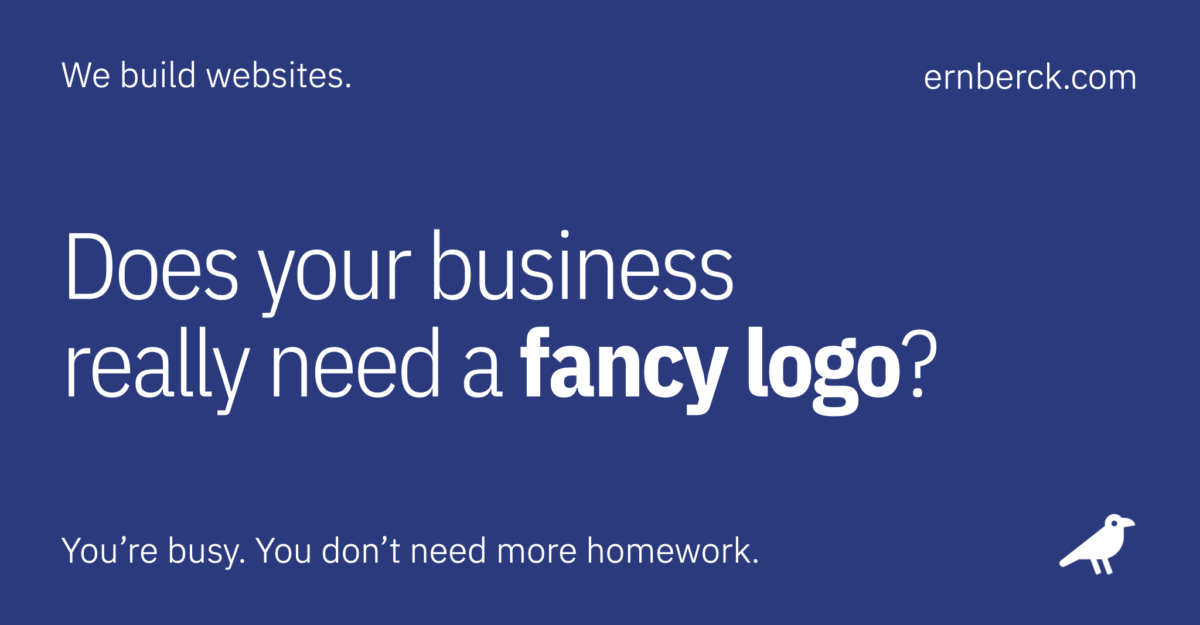Are logos really that important? A lot of experts don’t think so. So, before you spend a dime on discovery sessions, personas, or mood boards, read this article.
Logos are overrated
There, we said it. It’s a controversial opinion, especially if you’re a graphic designer or “brand strategist.” But honestly, some of the most recognizable brands in the world have logos that could have been created by an 8-year-old with a crayon (see Nike or Target). So, if you run a small business, should you spend thousands on a snappy logo? that’s a complicated question, so let’s start at the beginning.
What is a logo?
A logo (short for logotype) is a symbol or design that represents a company or organization. It’s often used on products, signs, and advertising materials to help consumers identify and remember the brand.
Logos can be simple or complex, and may include text, illustrations, or a combination of both. They are typically created by graphic designers or brand strategists and are intended to be easily recognizable and memorable.
Are there different types of logos?
Yes. There are a few different kinds of logos, including:
Wordmark
These logos use text — usually the company or brand name — as the primary design element. Coca-Cola and IBM are examples of wordmark logos.
Symbol
These logos use a symbol or icon to represent a company or organization. The Nike swoosh and Apple’s apple are examples of iconic logos.
Combination marks
These logos combine a symbol or icon with text. The FedEx logo is an example of a combination mark.
Mascot
These logos use a cartoon or illustrated character to represent a company or organization. The Geico Insurance gecko and the Kool-Aid Man are examples of mascot logos.
Note: These logo “types” are not mutually exclusive and many logos may fall into multiple categories.
What is a logo system?
A logo system, also known as a brand identity system or visual identity system, is a set of guidelines and elements that work together to create a consistent visual representation of a brand.
A logo system typically includes the primary logo, as well as secondary design components such as typography, color palettes, illustration, and imagery. This “collection” of narrowly-defined visual elements work together to represent a brand consistently across different mediums and contexts.
“The truth about logos is that they are not that hard to do. If you ask people in the U.S. what logos they like and recognize, they’ll name Target or Nike. Target for example, is just a dot with a circle around it, that’s all it is. So if you want a logo like Target, you don’t need to hire a designer, you barely need to know how to operate a computer program, the logo may as well be anything.”
— Michael Bierut / Pentagram
Does a logo have to be unique?
A logo should be unique in order to effectively represent and differentiate a brand. A unique logo can help to create positive first impressions, increase brand awareness, and build trust and credibility with consumers. A unique logo can also help to protect a brand from potential trademark infringement issues.
However, it’s important to note that being unique doesn’t mean being completely original. It’s very common to use elements that have been used before, but arranging or combining them in a new way, to create something new.
Note: A logo alone does not make a brand unique — It’s the combination of various elements such as visual identity, history, voice, and customer experience that make a brand unique. A distinctive logo is an important element, but it’s not the only one.
A few famous logos












What makes a logo memorable?
Others will have their own theories, but here are afew factors that can help make a logo memorable:
Simplicity: Simple designs are often more memorable than complex ones. A simple logo is easy to recognize and reproduce, making it more likely to be remembered.
Relevance: A design that is relevant to the company or organization it represents might be more memorable than one that isn’t. Relevance can be achieved by incorporating elements that are related to the company’s mission, values, or products and services.
Distinctiveness: All else being equal, a logo that stands out from others in your industry will be more memorable than one that is similar to others.
Flexibility: A logo that can be used in a wide variety of mediums and contexts will be more recognizable than one that is limited in its application.
Scalability: A logo should be able to be used in various contexts and sizes, whether it be on a smartphone, laptop, business card, or billboard.
Versatility: A logo should be able to be used in both color and black and white, and should work well in different formats and mediums, such as print or digital.
Consistency: A logo that is used consistently across all materials and platforms will be more memorable than one that changes all the time.
Color: Color can play an important role in making a logo memorable. The use of appropriate and consistent color can help to make a logo stand out, and also can evoke certain emotions and associations.
Longevity: A logo that has a timeless design will be more memorable than one that is trendy or fashionable. A timeless logo can be used for a long time without looking outdated.
Emotion: This is tricky, but if possible a logo should evoke an emotional connection with the target audience, whether it be through a specific design, color, imagery, or typography.
Note: An old graphic design adage claims that any logo that looks good in black an white will also look good in color. That’s probably true.

Michael Bierut
Clients used to ask me to send out press releases about their new logos and I would roll my eyes and think to myself: “No one gives a f*ck about your new logo.”
How much does a logo cost?
That’s a scary question. The cost of a logo can vary greatly depending on the designer or agency creating it, the complexity of the design, and the package of services included. A complete visual identity package which includes a logo, typography, color palette, imagery, and other design elements can cost even more.
Basic logo design
These logos are often created by freelance or entry-level designers, can cost anywhere from $50 to $500.
Mid-range logo design
Typically created by a more experienced designer or small design agency. They can cost anywhere from $500 to $5,000.
High-end logo design
Created by a top-level designer or a large agency, can cost anywhere from $5,000 to $50,000 or more.
Stratospheric logo design
Logos designed by world-renowned agencies such as Pentagram can cost in the millions of dollars. Sounds weird — but from a value pricing perspective — the more you pay, the lower your risk. Remember the old saying “Nobody ever got fired for hiring IBM”?
Cost vs experience
It’s important to keep in mind that the cost of a logo is not always an indicator of its quality. A logo created by a small design agency or a freelance designer can be just as effective and professional as one created by a larger agency. You should always evaluate the experience and portfolio of the designer or agency and to see if they understand your business and your target audience.
Sorry, but nobody cares about your logo.
So before you spend a nickel on “discovery” sessions, “stylescape” development, color palette analysis, or customer avatars, watch this video — At least twice. And remember: It’s the customer that defines your brand, not you.
Who is Michael Bierut?
Michael Bierut is a renowned graphic designer that studied at the University of Cincinnati’s College of Design, Architecture, Art and Planning — graduating summa cum laude in 1980. He worked for ten years at Vignelli Associates before joining Pentagram as a partner in 1990.
His clients at Pentagram include Disney, Benetton, Motorola, The New York Times, Verizon, Saks Fifth Avenue, Billboard Magazine, MIT Media Lab, Mastercard, Princeton University, United Airlines, and the New York Jets.
Bierut is a senior critic in graphic design at the Yale School of Art and a lecturer in the practice of design and management at the Yale School of Management.
Does my business really need a logo?
A logo can be an important part of a brand’s visual identity. It serves as a symbol that represents your company or organization, and it’s often the first thing that consumers will see when they encounter your business.
A well-designed logo can help to create a positive first impression, increase brand awareness and recall, and build trust and credibility with your customers. A logo that is easily recognizable and memorable can also help to differentiate your business and make it stand out in the marketplace.
However, it’s important to note that a logo alone is not enough to create a strong brand. A logo is a visual representation of a brand, but a brand is much more than just a logo. It’s the overall perception that consumers have of an organization, and that perception is shaped by a variety of factors, such as product quality, customer service, marketing, social media presence, and more.
Summary
A logo can be a powerful tool in differentiating your business, but it should be part of an overall brand strategy that includes a consistent message and experience across all customer touchpoints.
If you have a limited budget, it can be challenging to decide whether to invest in branding or marketing. Both strategies are important for success, but they have different goals and focus on different aspects of your business.
If you’re just starting out and your business is not well-established, it may be more important to focus on marketing in order to generate leads and sales. This can include activities such as advertising, social media, and customer service. By generating leads and sales, you can build a customer base and start to establish a reputation for your business.
Honestly, we love logos. We just think business owners fret over them too much. It’s not as complicated as a bunch of marketing “experts” would have you believe.
Related
Sources
Revised: Thursday January 26, 2023 at 2:25:09 PM PST
